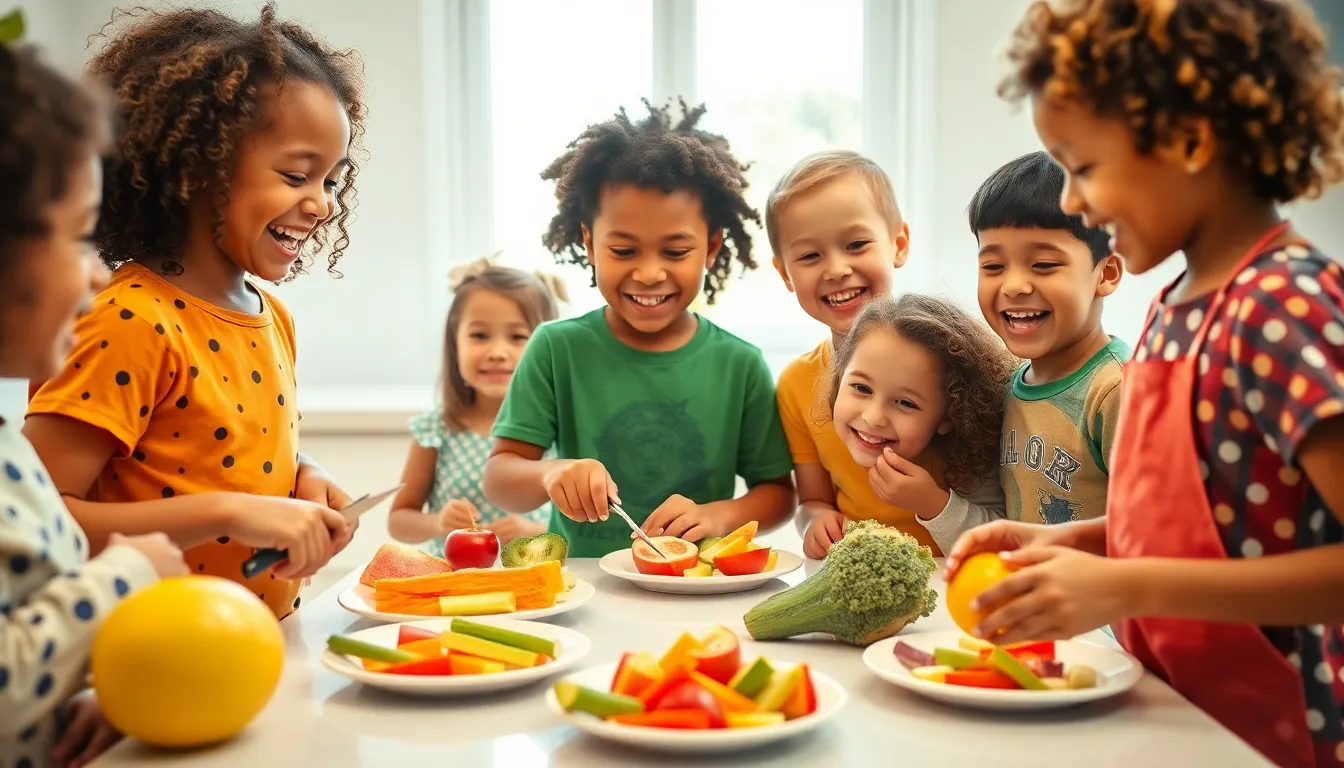Table of Contents
ToggleWhen it comes to food, kids can be a tough crowd. One minute they’re devouring broccoli like it’s candy, and the next, they’re staging a revolt over a single pea. Navigating the world of nutrition for children can feel like a high-stakes game of hide and seek, but it doesn’t have to be a chore. With the right guidance, healthy eating can transform from a dreaded task into an exciting adventure.
Food and nutrition articles for kids aren’t just about teaching the basics; they’re about sparking curiosity and making learning fun. Imagine a world where kids are eager to try new foods because they understand their superpowers! Packed with engaging tips and playful insights, these articles can turn even the pickiest eaters into enthusiastic little food explorers. So let’s dive into the delicious world of nutrition and discover how to make healthy eating a delightful journey for every child.
Importance Of Food And Nutrition Articles For Kids
Food and nutrition articles provide essential knowledge about healthy eating. They promote an understanding of different food groups, encouraging balanced diets. Kids learn about vitamins, minerals, and their significance for growth and development. Articles aimed at children use engaging language and colorful visuals, making nutrition appealing.
Education about nutrition helps tackle issues like obesity. According to the CDC, the prevalence of obesity among children and adolescents was 19.7% in 2017-2020. Providing relatable content can empower kids to make informed choices, combating this growing concern. Incorporating fun facts about food can increase interest in healthy options.
Nutritional resources help develop lifelong healthy habits. Children exposed to the basics of nutrition early are more likely to maintain good eating habits as they grow. Articles can also introduce the idea of trying new foods, transforming the experience into an adventure.
Furthermore, nutrition articles can strengthen relationships. Parents and kids may bond over cooking and trying new recipes together. Shared meals become fun learning moments, reinforcing positive eating practices.
Creating a supportive environment for healthy eating is crucial. Articles contribute by addressing common misconceptions about food. Encouraging curiosity and experimentation with different cuisines fosters a love for diverse flavors.
Being well-informed through engaging articles instills confidence in children. Knowledgeable kids feel empowered to make healthier choices in school and social settings. In summary, food and nutrition articles hold significance in shaping a healthier future for children.
Types Of Articles Available

Various types of food and nutrition articles for kids exist, each designed to engage and educate young readers effectively.
Educational Articles
Educational articles provide valuable information on nutrition basics. Kids learn about food groups, vitamins, and minerals through engaging content. Understanding healthy eating habits begins with fun facts about different foods. These articles often utilize colorful graphics to enhance comprehension. Parents can easily use them as a teaching resource. Incorporating quizzes and fun challenges helps reinforce learning. As a result, children develop an informed perspective on the foods they consume.
Fun Activities And Recipes
Fun activities and recipes offer interactive ways for kids to explore nutrition. Cooking games encourage hands-on learning in the kitchen. Recipes geared towards children utilize simple ingredients and steps. Kids gain confidence in their culinary skills while trying new flavors. Activities like food art promote creativity and make healthy eating visually appealing. Craft ideas also tie into nutrition lessons, providing a holistic approach. Involving children in meal planning fosters excitement about healthy choices.
Benefits Of Reading Nutrition Articles
Reading nutrition articles provides several significant benefits for children. These resources help instill healthy eating habits early on.
Promoting Healthy Eating Habits
Nutrition articles introduce children to balanced diets and essential food groups. Engaging formats like colorful illustrations and relatable language make concepts easy to understand. Articles emphasize the importance of vitamins and minerals for growth, reinforcing knowledge through enjoyable content. Children develop positive relationships with food, enjoying nutritious meals rather than viewing them as chores. This foundation equips kids to make healthy choices as they navigate school and social settings. By fostering an understanding of portions and food variety, nutrition articles empower children to embrace lifelong healthy eating patterns.
Encouraging Curiosity About Food
Curiosity about food blossoms when kids engage with nutrition articles. Articles present information in intriguing ways, encouraging exploration of different cuisines and ingredients. Kids discover diverse flavors and cooking methods, gaining excitement about trying new foods. Interactive elements such as quizzes and fun facts capture attention, making learning enjoyable. This approach inspires children to ask questions and seek out new experiences in the kitchen. Parents also benefit, as shared meal preparation fosters bonding opportunities. By encouraging adventure in food choices, nutrition articles help cultivate an appreciation for healthy eating.
Tips For Parents
Parents play a crucial role in helping children develop healthy eating habits. Emphasizing engaging resources can make nutrition enjoyable for kids.
Selecting Age-Appropriate Content
Select materials that match the child’s developmental stage. Younger children benefit from colorful visuals and simple language. Tweens may appreciate more detailed information that sparks curiosity. Age-appropriate content keeps kids interested and enhances understanding of nutrition basics. Use articles that relate to their favorite foods or popular culture. Relatable examples can make learning about food groups and vitamins more exciting. Evaluate the complexity of the material to ensure it aligns with the child’s comprehension level. Providing a mix of fun facts and practical tips helps sustain interest.
Engaging Children In The Learning Process
Engaging children actively boosts retention and enjoyment. Involve kids in cooking to connect what they learn with real-life experiences. Encourage participation in meal planning by asking their opinions on recipes. Create fun challenges, like trying a new fruit or vegetable each week. Making the learning process interactive fosters curiosity and exploration. Share stories about different cultures and their cuisines to inspire adventurous eating. Quizzes and games related to food facts can boost engagement and knowledge retention. Prioritizing hands-on activities makes learning about nutrition exciting and impactful.
Food and nutrition articles for kids play a crucial role in shaping healthy eating habits. By making nutrition engaging and fun, these resources can spark children’s curiosity and encourage them to explore new foods.
Empowering kids with knowledge about food groups and balanced diets not only supports their growth but also helps combat rising obesity rates. Involving children in cooking and meal planning fosters family bonds and instills confidence in their food choices.
With the right approach, parents can turn healthy eating into an enjoyable adventure, paving the way for a lifetime of nutritious habits. Embracing the journey of food exploration together can transform mealtime into a cherished experience for both kids and parents alike.





